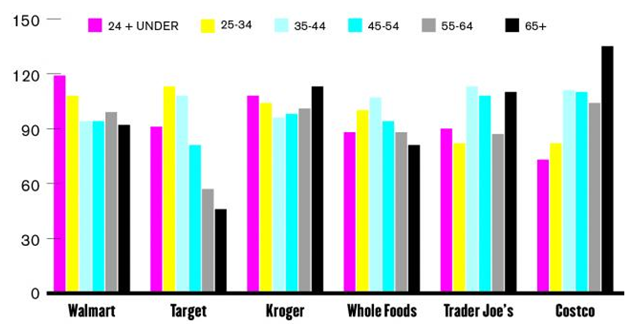Walmart Segmentation, Targeting and Positioning
Walmart segmentation, targeting and positioning is the core focus of Walmart strategic marketing. Segmentation refers to dividing population into groups according to certain characteristics, whereas targeting is associated with choosing specific groups identified as a result of segmentation to sell products. Positioning refers to the selection of the marketing mix the most suitable for the target customer segment.
Walmart uses mono-segment type of positioning and accordingly, Walmart marketing management appeals to single customer segment who place greater value on the price attribute of products compared to other attributes.
The following table illustrates Walmart segmentation, targeting and positioning:
| Type of segmentation | Segmentation criteria | Walmart target segment |
|
Geographic |
Region | Domestic and international |
| Density | Urban and rural areas | |
|
Demographic |
Age | Individuals of all age categories |
| Gender | Males and Females | |
| Life-cycle stage | Bachelor Stage young, single people not living at home
Newly Married Couples young, no children Full Nest I youngest child under six Full Nest II youngest child six or over Full Nest III older married couples with dependent children Empty Nest I older married couples, no children living with them Empty Nest II older married couples, retired, no children living at home Solitary Survivor I in labor force Solitary Survivor II retired |
|
| Income | Individuals and households with low incomes and middle class | |
| Occupation | Students, manual workers, floor level employees and middle level managers in public and private sectors | |
| Behavioral | Degree of loyalty | ‘Hard core loyals’, i.e. individuals who always purchase the product / brand in question.
‘Switchers’, i.e.individuals who do not specifically seek out a particular brand, but rather purchase the brand available to them at time of need, or that which was on sale |
| Benefits sought | Cost advantage | |
| Personality | Reserved and cost-conscious individuals | |
| User status | non-users, potential users, first-time users, regular users, or ex-users of a product | |
| Psychographic | Social class | Lower class, working and middle class |
| Lifestyle | Resigned, struggler and mainstreamer individuals according to Cross Cultural Consumer Characterization by Young & Rubican |
Walmart segmentation, targeting and positioning
It is important to specify that although Walmart attempts to target customers of all ages via its marketing communication messages, particular attention is paid to young consumers, dubbed as generation X due to the strategic importance of achieving the loyalty of young consumers for long-term perspectives. Along with the promise of cheap prices, Walmart attracts Millemials via effective integration of social media marketing into its marketing communications strategy. This strategy is proving to be effective so far.As it is illustrated in figure below, Millennials favour Walmart over stores including Target, Costco, Trader Joe’s, and Whole Foods in North America[1]
Major retailers index with shoppers with age group[1]
Walmart Stores Inc. Report constitutes a comprehensive analysis of marketing strategy and business strategy of Walmart. The report illustrates the application of the major analytical strategic frameworks in business studies such as SWOT, PESTEL, Porter’s Five Forces, Value Chain analysis and McKinsey 7S Model on Walmart. Moreover, the report contains analysis of Walmart’s leadership and organizational structure and discusses the issues of corporate social responsibility.
[1] Boxall, A. (2015) “Walmart shifts away from print advertising and towards mobile to better target Millennials” Moby Affiliates, Available at: http://www.mobyaffiliates.com/blog/walmart-shifts-away-from-print-advertising-and-towards-mobile-to-better-target-millennials/
[2] 100 = Average Purchase Activity, Source: INFOSCOUT


